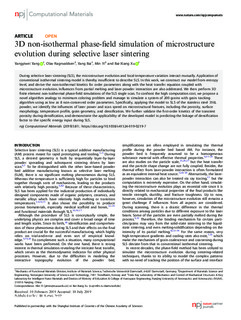| dc.contributor.author | Yang, Yangyiwei | |
| dc.contributor.author | Ragnvaldsen, Olav | |
| dc.contributor.author | Bai, Yang | |
| dc.contributor.author | Yi, Min | |
| dc.contributor.author | Xu, Bai-Xiang | |
| dc.date.accessioned | 2020-02-11T09:47:27Z | |
| dc.date.available | 2020-02-11T09:47:27Z | |
| dc.date.created | 2019-09-26T14:08:27Z | |
| dc.date.issued | 2019 | |
| dc.identifier.citation | npj Computational Materials. 2019, 5 (1), 1-12. | nb_NO |
| dc.identifier.issn | 2057-3960 | |
| dc.identifier.uri | http://hdl.handle.net/11250/2640958 | |
| dc.description.abstract | During selective laser sintering (SLS), the microstructure evolution and local temperature variation interact mutually. Application of conventional isothermal sintering model is thereby insufficient to describe SLS. In this work, we construct our model from entropy level, and derive the non-isothermal kinetics for order parameters along with the heat transfer equation coupled with microstructure evolution. Influences from partial melting and laser-powder interaction are also addressed. We then perform 3D finite element non-isothermal phase-field simulations of the SLS single scan. To confront the high computation cost, we propose a novel algorithm analogy to minimum coloring problem and manage to simulate a system of 200 grains with grain tracking algorithm using as low as 8 non-conserved order parameters. Specifically, applying the model to SLS of the stainless steel 316L powder, we identify the influences of laser power and scan speed on microstructural features, including the porosity, surface morphology, temperature profile, grain geometry, and densification. We further validate the first-order kinetics of the transient porosity during densification, and demonstrate the applicability of the developed model in predicting the linkage of densification factor to the specific energy input during SLS. | nb_NO |
| dc.language.iso | eng | nb_NO |
| dc.publisher | Nature Research | nb_NO |
| dc.rights | Navngivelse 4.0 Internasjonal | * |
| dc.rights.uri | http://creativecommons.org/licenses/by/4.0/deed.no | * |
| dc.title | 3D non-isothermal phase-field simulation of microstructure evolution during selective laser sintering | nb_NO |
| dc.type | Journal article | nb_NO |
| dc.type | Peer reviewed | nb_NO |
| dc.description.version | publishedVersion | nb_NO |
| dc.source.pagenumber | 1-12 | nb_NO |
| dc.source.volume | 5 | nb_NO |
| dc.source.journal | npj Computational Materials | nb_NO |
| dc.source.issue | 1 | nb_NO |
| dc.identifier.doi | 10.1038/s41524-019-0219-7 | |
| dc.identifier.cristin | 1729640 | |
| dc.description.localcode | © The Author(s) 2019 This article is licensed under a Creative CommonsAttribution 4.0 International License, which permits use, sharing,adaptation, distribution and reproduction in any medium or format, as long as you give appropriate credit to the original author(s) and the source, provide a link to the Creative Commons license, and indicate if changes were made. The images or other third partymaterial in this article are included in the article’s Creative Commons license, unless indicated otherwise in a credit line to the material. If material is not included in the article’s Creative Commons license and your intended use is not permitted by statutory regulation or exceeds the permitted use, you will need to obtain permission directlyfrom the copyright holder. To view a copy of this license, visithttp://creativecommons.org/licenses/by/4.0/. | nb_NO |
| cristin.unitcode | 194,66,35,0 | |
| cristin.unitname | Institutt for materialteknologi | |
| cristin.ispublished | true | |
| cristin.fulltext | original | |
| cristin.qualitycode | 1 | |

